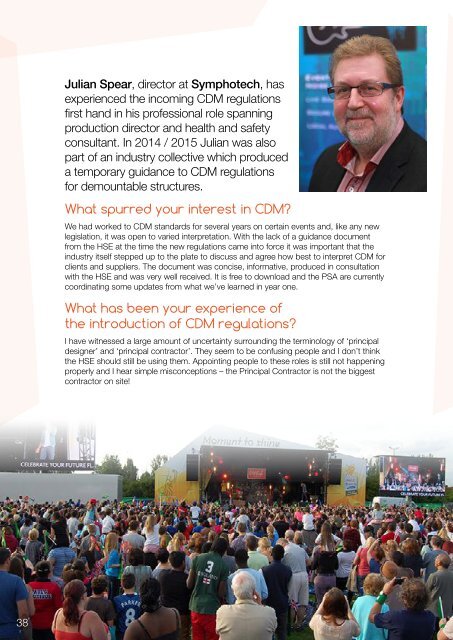Buyer’s
Zql2t
Zql2t
You also want an ePaper? Increase the reach of your titles
YUMPU automatically turns print PDFs into web optimized ePapers that Google loves.
Julian Spear, director at Symphotech, has<br />
experienced the incoming CDM regulations<br />
first hand in his professional role spanning<br />
production director and health and safety<br />
consultant. In 2014 / 2015 Julian was also<br />
part of an industry collective which produced<br />
a temporary guidance to CDM regulations<br />
for demountable structures.<br />
What spurred your interest in CDM?<br />
We had worked to CDM standards for several years on certain events and, like any new<br />
legislation, it was open to varied interpretation. With the lack of a guidance document<br />
from the HSE at the time the new regulations came into force it was important that the<br />
industry itself stepped up to the plate to discuss and agree how best to interpret CDM for<br />
clients and suppliers. The document was concise, informative, produced in consultation<br />
with the HSE and was very well received. It is free to download and the PSA are currently<br />
coordinating some updates from what we’ve learned in year one.<br />
What has been your experience of<br />
the introduction of CDM regulations?<br />
I have witnessed a large amount of uncertainty surrounding the terminology of ‘principal<br />
designer’ and ‘principal contractor’. They seem to be confusing people and I don’t think<br />
the HSE should still be using them. Appointing people to these roles is still not happening<br />
properly and I hear simple misconceptions – the Principal Contractor is not the biggest<br />
contractor on site!<br />
CDM is all about an effective management<br />
structure, which I’m all in favour of and a<br />
simpler labelling of roles would help – the<br />
production manager on most event site will be<br />
undertaking these roles.<br />
Enforcement is being phased in very slowly,<br />
so there are still discrepancies as a significant<br />
proportion of event sites have not yet applied<br />
CDM rigorously. In a lot of places suppliers and<br />
clients still aren’t being asked for appropriate<br />
sign-off sheets, so we are seeing a lot of large<br />
demountable structures or pieces of technical<br />
production equipment being installed and<br />
then audiences entering events without any<br />
sign off to say they have been installed as per<br />
the approved plan, which clearly presents a<br />
potentially dangerous situation.<br />
We build in a contingency in our planning<br />
that some things will differ once you get on site, so maybe allow for a small (say a small<br />
variation in the weight of lights / set / video deployed in a stage roof across a festival<br />
weekend). Anything outside of the accepted variation and the principal contractor<br />
(production manager in the real world) responsible will have the information and<br />
jurisdiction to decline that change with evidence.<br />
Do you think CDM will improve safety at events?<br />
Yes, once everyone understands it and gets used to employing the management systems<br />
that create a clear audit trail. In a nutshell something has been designed properly,<br />
checked to be safe, installed properly and then signed off to confirm that installation as<br />
take place as per the approved plan.<br />
38<br />
39


